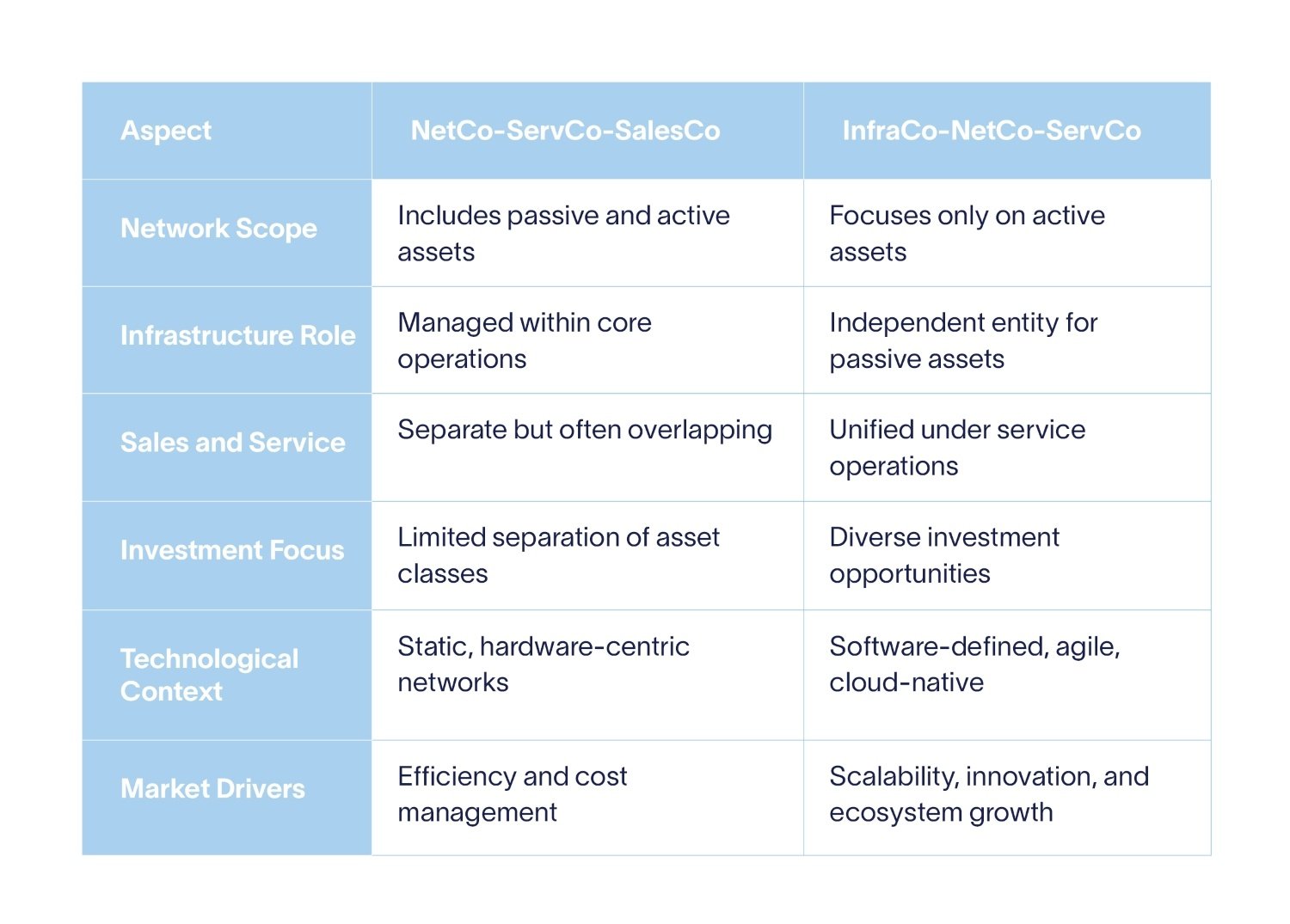INSIGHTS
From NetCo-ServCo-SalesCo to InfraCo-NetCo-ServCo: An evolution
Altman Solon is the largest global TMT consulting firm with expertise in telecommunications consulting. In the following insight, we examine how telcos are evolving their business structures through strategic de-layering.
A combination of technological investments, competitive pressures, and investor demands has compelled telecommunications companies to evolve structurally. While strategic delayering has occurred over the past 20 years, new models that separate service and infrastructure units are emerging.
The earlier model of NetCo-ServCo-SalesCo and the more contemporary approach of InfraCo-NetCo-ServCo both share the foundational goal of delayering operations for agility and efficiency while creating value. However, the shift is not just structural; but a response to changing industry dynamics, technological advances, and new business opportunities.
The original NetCo-ServCo-SalesCo model
In the early 2000s, the NetCo-ServCo-SalesCo framework emerged as a way of delayering integrated operators to tackle inefficiencies while driving shareholder value. This model was adopted by many legacy telecommunications companies, including several major European and Asian operators.
NetCo managed both active (core network, radio) and passive (ducts, towers) network assets.
ServCo acted as the service delivery arm, creating and operating products such as data, voice, and enterprise solutions.
SalesCo focused on customer acquisition and distribution, covering marketing, sales, enterprise, and retail.
This structure allowed specialization and efficiency gains, but it also presented significant limitations:
- Limited scalability: The integration of active and passive infrastructure made infrastructure sharing challenging.
- Operational overlap: The delineation between sales and service operations was often ambiguous, leading to inefficiencies in go-to-market strategies.
- Investor challenges: The network-heavy operations struggled to attract infrastructure-specific investments without carving out passive assets.
The modern modular operating model
Recognizing these limitations, industry leaders began evolving their approach. Today’s newer InfraCo-NetCo-ServCo model represents a refined, modular approach better suited for the digital era.
InfraCo is responsible for all passive infrastructure, such as ducts, towers, and fiber assets. It operates as an independent entity, often attracting infrastructure-specific investors.
NetCo oversees all active elements of the network, focusing on innovation in areas like software-defined networking, edge computing, and Open RAN.
ServCo remains a customer-facing entity but benefits from a more flexible infrastructure ecosystem.
This transition has already been implemented by forward-thinking telecom operators worldwide, enabling them to focus purely on infrastructure investment and monetization.
Case study 1: African telecom operator's InfraCo strategy
A leading African telecom operator established a dedicated infrastructure entity to drive efficiency and unlock new investment opportunities. Through this transition:
- The infrastructure entity attracted $2 billion in infrastructure-focused investments, enabling rapid fiber expansion.
- Network modernization efforts improved 5G rollout speed by 40%.
- Service operations launched innovative digital financial services, increasing customer engagement and ARPU.
- Expanded fiber-optic reach by over 100,000 kilometers, enhancing connectivity across multiple nations.
- Enabled new partnerships with regional internet service providers (ISPs), promoting greater network-sharing efficiencies.
Case study 2: Asia-Pacific operator's 5G expansion through InfraCo strategy
A leading telecom operator in the Asia-Pacific region transitioned to a modular operating structure to support its ambitious 5G rollout. By creating an independent infrastructure entity to manage tower and fiber assets, the company achieved:
- Rapid 5G deployment with a 40% increase in tower-sharing agreements.
- Infrastructure cost savings of 25%, enabling reinvestment in advanced network capabilities.
- New revenue streams by leasing passive assets to multiple operators and enterprises.
Case study 3: Middle Eastern operator unlocks regional expansion with new model
A major Middle Eastern telecommunications provider leveraged the modular operating framework to expand its fiber network across multiple countries. By separating passive infrastructure into an independent entity, the company achieved:
- $1.5 billion in foreign direct investment, fueling regional growth.
- Improved cross-border collaboration by offering open-access infrastructure to smaller operators.
- Accelerated fiber deployment by 35%, supporting government-led digital transformation initiatives.
Case study 4: European operator's success with modernized structure
One of Europe's largest telecom operators embraced the modular operating model to modernize its network infrastructure and drive efficiency across multiple markets. Through this transformation, the operator:
- Established an independent infrastructure entity, enabling greater focus on fiber deployment and passive asset management.
- Attracted €1.8 billion ($2 billion) in external investment, accelerating its fiber rollout across several countries.
- Increased fiber-to-the-home (FTTH) passings by 50% within two years.
- Formed partnerships with regional and international service providers, promoting infrastructure sharing and reducing deployment costs.
- Enhanced customer experience through faster, more reliable broadband services.
Key differences between NetCo-ServCo-SalesCo and InfraCo-NetCo-ServCo models

Key differences between NetCo-ServCo-SalesCo and InfraCo-NetCo-ServCo models

A necessary evolution in telecommunications
The shift from traditional integrated models to modular operating structures is not merely an incremental improvement—it is a full transformation reflecting how the telecommunications industry is adapting to modern demands.
- From efficiency-driven to innovation-led: The older model focused on cost efficiencies, whereas the new model embraces digital transformation and customer-centric innovation.
- From siloed to ecosystem-driven: Today’s telecom operators must interact with hyperscalers, cloud providers, and public-sector stakeholders in a more open and modular way.
- From static to agile infrastructure: Advances in cloud-native networks, AI, and automation demand a separation between passive and active assets for optimal performance.
Operators that embrace this transformation stand to gain significant advantages. The modular operating model enables:
- Scalability through specialized infrastructure investments
- Technological specialization by decoupling network operations
- Investment flexibility that attracts diverse capital sources
As the industry moves towards a digital-first future, adopting this model is not just a choice—it is a necessity for long-term competitiveness.
If you would like to know more about our insights on telecommunication operating models, please fill out the form below.